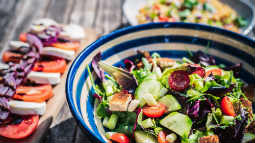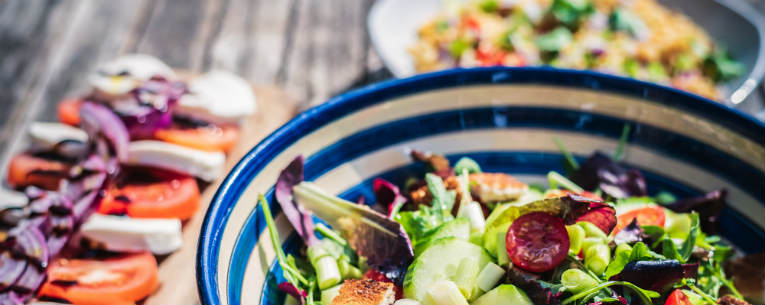Eating healthy while traveling is tough enough when you’re taking a quick weekend getaway here or a family vacation there.
Now imagine being a stalwart business traveler, subject to the offerings of airport snack shacks and hotel breakfast spreads. It’s enough to give one indigestion just thinking about it — or worse. In fact, the data shows that folks who travel two or more weeks each month are more likely to experience obesity than less frequent travelers. Add jet lag, uncomfortable beds and other inconveniences that make it tough to find a healthy rhythm, and it’s a recipe for feeling less than at your best.1
Don’t worry, we have something that will hit the spot: tips and advice for eating healthy while traveling, no matter if you’re just going to grandma’s house for Thanksgiving or planning a three-week, multi-state business trek spent in board rooms, the economy class cabin and two-star hotels.
So, slip a bag of almonds and some citrus fruit in your carry-on and get ready for two scoops of knowledge. Here we go…
Eating Healthy While Traveling on Planes and Through Airports
Getting from a parking deck C to the airport, through the TSA checkpoint, onto the plane and then reaching your final destination can be a grueling gauntlet of obstacles against the clock.
It’s easy to grab a burger — or even something you wrongly assume to be healthy, such as chicken salad wrap registering 1,200 calories — when you’re more focused on simply getting from here to there than how you’ll feel later. But there are few cheats you can employ to avoid grabbing something now that you’ll regret in a few hours.
First off, BYOS, or bring your own snacks. Yes, yogurt and applesauce count as liquids and gels in the TSA’s playbook, but simply look for them in sizes of 3.4 oz. or less (or buy leak-proof containers that measure in at that amount) to get them through security. Granola bars, nuts and even trail mix are even easier to tote through the terminal and onto the plane.2
Depending on your airline, know that eating healthy while traveling through the air is a bit easier than it was decades ago. Virgin America, for example, gets high marks for offering vegan options such as butternut squash and pecan salad. Its average meal comes in at just 408 calories.3
But perhaps the soundest advice for touching down feeling ready for anything is to drink plenty of water. Airplane’s lower humidity, a cocktail in the lounge and some salty snacks all contribute to dehydration, so be sure to keep some H2O by your side.4
Eating Healthy at the Hotel
Maybe you’re one of the fortunate ones who can awake to a room service egg white omelet and fruit cup, enjoy a relaxing lunch of salmon salad — light on the dressing — on the impressive veranda, and then settle in with a dinner of avocado rolls and miso soup at the five-star sushi bar. All under your hotel’s roof and all on the corporate credit card.
Of course, that’s not often the reality. When you take a late flight into Rochester, and arrive at your suburban hotel famished after 8 p.m., the options are often limited. If you’re lucky, maybe the hotel pantry has some overpriced Ramen Noodles or Hot Pockets.
Thankfully, this is 2018. And it’s a time when you can make your own room service thanks to delivery apps including UberEats, Grubhub and Seamless, all of which are available for iOS and Android-powered smartphones.5 Download one or two before you depart, checking to see which are available at your destination, so you’re good to go when hunger calls.
Plus, even that initial scenario we cooked up, where you’re heating up noodles with 1,800-plus mg of sodium using your in-room coffee maker, is fading out of existence. That’s because more and more hotels are serving up holistic healthy experiences that include meals you can feel good about. Fairmont takes the (rice) cake, with offerings including robust gym facilities, less toxic cleaning products, and menu items that can accommodate food allergies. Hilton also gets props for teaming up with Johnson and Wales University, a top-shelf culinary institute, for creating menus highlighted by sesame ahi tuna and a breakfast that promises low-fat, high-energy choices.6
If all else fails, just grab that oatmeal packet you put in your dopp kit after reading this article. And fire up the coffee maker.
Eating healthy while traveling for business
Whether you’re attending a big client meet-and-greet, marking a company milestone, or celebrating a promotion or retirement, there is a go-to dining destination: the steakhouse.
From Outback to Morton’s and Smith Wollensky — and working your way up and down the steak chains — it’s no mystery what’s on the menu: meat, potatoes, and maybe even a deep-fried onion.
Here are a few tips for navigating your way through what can be an all-time dinner, in terms of building camaraderie with coworkers and amassing calories.
- Go grass fed: Not only are these leaner and healthier, but grass-fed beef tastes better, too.
- Skip the potato: Fries and even a baked potato sans fixings add hundreds of extra calories to a meal.
- When in doubt, choose the sirloin: You may crave the ribeye or porterhouse, but this is a choice cut you can feel good about devouring.7
Of course, not every day at work is a five-course, $500 celebration (that’s without gratuity). Sometimes you’re hoofing it on the cheap carpet of a convention center for 10 to 12 hours, wheeling and dealing from a 10’ X 10’ branded booth and squeezing in meals when you can.
Here are a few tips for surviving what can be a long slog of repeating elevator pitches and glad-handing strangers:
- Pack plenty of healthy snacks. And drink plenty of water.
- Avoid the urge to overdo it on caffeine. Even if it was a late night. And the free coffee both is next to yours.
- Pass on unhealthy freebies. It’s easy to go trick-or-treating from booth to booth. But if you wouldn’t eat it if you had to pay for it, whether it’s a Moon Pie or pork belly nachos, don’t eat it just because it’s free.8
Eating Healthy While Traveling for a Marathon or other Competition
There is a big difference between trying to eat healthy while chilling at the beach, and needing a precise and particular diet before and after running 26.2 miles (or whichever activity for whatever duration).
We’re not going to get into advising you the best way to carbo-boost or replenish your body after an all-time great athletic achievement. But here is a little common-sense advice that may not occur to you when you’re consumed with packing moisture-wicking attire and figuring out where to pick up your race bib: research your meal options. If you’re making a trip for a popular marathon or a competition such as an Ironman Triathlon, you’ll have plenty of company. Look at menus at potential restaurants to make sure there are options to fit your nutritional needs. Also book a table with an app such as OpenTable to ensure you’re not waiting 90 minutes for a seat or left on the outside looking in.9
Eating healthy while traveling on a restricted diet
Many people love chain restaurants: the prevalence, consistency of menu and those free appetizers they score thanks to loyalty cards that can be used in Boston or Boise.
And here is one more reason: they can be a solid option for the 15 million Americans who deal with food allergies. That’s because if you find a meal you can safely enjoy at a major chain — Longhorn Steakhouse, for example — then you have 500-plus restaurants you can enjoy that meal at when you’re hundreds of miles away from home.10
To that end, other chains with menus that are the friendliest to food allergies include Maggiano’s Little Italy, Bertucci’s Italian Restaurant, Mellow Mushroom, and Chipotle, where there are no eggs, tree nuts or peanuts.11
Eating healthy while traveling with the family
Maybe, just maybe you’re one of those families that are really on top of it. You know the ones; they have packing lists checked off and they prepare for a cross-country trip by packing a big, healthy picnic lunch. But more than likely, that’s not you. Instead, you may resort to unloading the minivan at fast food joints and greasy spoons for stressful, belly-filling pit stops. Well, there is a better way that doesn’t involve diligently packing a dozen PPJ sandwiches or ordering the same amount of bacon cheeseburgers and fried chicken sandwiches from the drive-thru window. We’re talking about the grocery store. Not only does the typical grocer offer plenty of options for healthy meals when you’re on the move, from hummus and carrot sticks to fresh deli meat and wheat wraps, but the many aisles of a grocery store let you stretch your legs and likely save a few bucks along the way.
Eating healthy on the run is hard if you’re simply travelling 100 miles away and back the same day. Once you have a real vacation with over-packed itineraries and under-nourished travelers, it can be a real challenge. But don’t sweat it. With a little planning and a smidgeon of self-control, you too can get to your destination and back home with fuel you can feel good about.
Related Articles









Share this Page